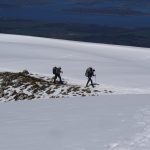

Do you still smirk at hikers who use these trekking sticks? Let me explain why it might be time to reconsider.
Sticks improve balance. That doesn’t mean you have to lean on them with your full weight because you’d stumble otherwise, but the feedback from your hands is faster and more intense than from your feet and you correct displacements earlier, saving lots of energy you’d otherwise burn with your lower leg muscles. The effect multiplies when you are carrying a backpack. You also feel safer if your body gets less re-balancing requests.
Because the remaining micro-displacements are smaller, the pressure of your feet against the ground stays more equal. This can make the difference between crashing or not through a surface layer, say firn or thin ice. The principle is basically the same as with snowshoes which is why you cross a snow slope much easier with sticks.
They also increase stability when you are taking big steps up or down. While you shift your weight from one foot to the other, there’s always an unstable phase which is way more precarious if the two steps differ significantly in height. Sticks save you from bending down or reaching out for manual support, thus bridging the gap between walking and climbing.
Sticks engage your upper body in the work. Going upwards you can pass up to 30% of it to arms and shoulders, so in terms of energy management they turn from being mere payload to becoming part of the engine.
If you are walking downwards, every downstep includes a micro fall, and for reasons of anatomy it’s almost impossible to compensate that with your muscles. As a result, meniscus and cartilages get the impact, and many tiny impacts accumulate to deterioration at some point. So sticks protect your knee and hip joints.
Sticks also give you the ability to feel your way. This might sound ridiculous, but I once had to walk down 1.500hm of slippery mountain paths in pitch darkness without any light on me (don’t ask me why, please). Even with sticks it was a five hour long descent; without them it would have been impossible. And clearly sometimes you simply want to test the ground in plain daylight, too.
Last but not least it’s easy to do. Modern sticks weigh down to some 200g. They can be of additional use when setting up an improvised poncho tent, as a camera pole (yes, there are models with integrated 1/4″ thread), to fend off a bear. Well, maybe not, but they are cool, and who minds another top notch gadget to show? 🙂
Having said this, let me give you some basics of proper choice and use:
- Choose the right length. If you stand upright with a right-angled elbow, the position of your hand indicates the correct length. For most persons it would be around 120cm. To go down, you want some more length, for steep climbs you need up to 20cm less. Adjustable height is one option; an elongated grip which you can also grasp on its lower part is the better choice.
- Choose the right system. Most sticks are telescopic, but this makes them heavier as well as prone to pushing together at the wrong moment. Plus, telescopic systems are sensible to sand. The alternative is a multi-part stick. You have to assemble those before you start (though there are some pretty smart systems) and some of them produce a faint, clattering sound while walking, but they are also more stable and pack smaller.
- Choose the right handle straps. Wider straps are better since they carry a load (you always grip through the straps from below, thus putting your weight mostly on the heels of hands), so you don’t want thin straps or hard edges here.
- Choose the right rhythm. Ever seen how we naturally walk, swinging one foot forward together with the opposite arm? That’s how you use your stick: always use left stick in unison with your right foot. Remember: support means balance here, so you want the widest distance between foot and stick tip; it’s not about adding your biceps strength to the supporting leg.
Let me finish with my very first stick experience. As a newbie, I was invited by a group of pilots to hike up some 1.200hm on a mountain with full gear, and one of the elder guys offered me a spare set of sticks. I supposed it was a tool only old farts would use, but it felt impolite to reject the offer. When the environment became steep ice and snow fields closer to the summit, the sticks turned out to be incredibly helpful – and the “old farts” turned out to be some of the most skilled mountaineers ever. Since then I have recommended sticks to many a friend, sometimes receiving a grinning “I don’t need that sort of stuff”, and I knew exactly what was going on in these minds 🙂
